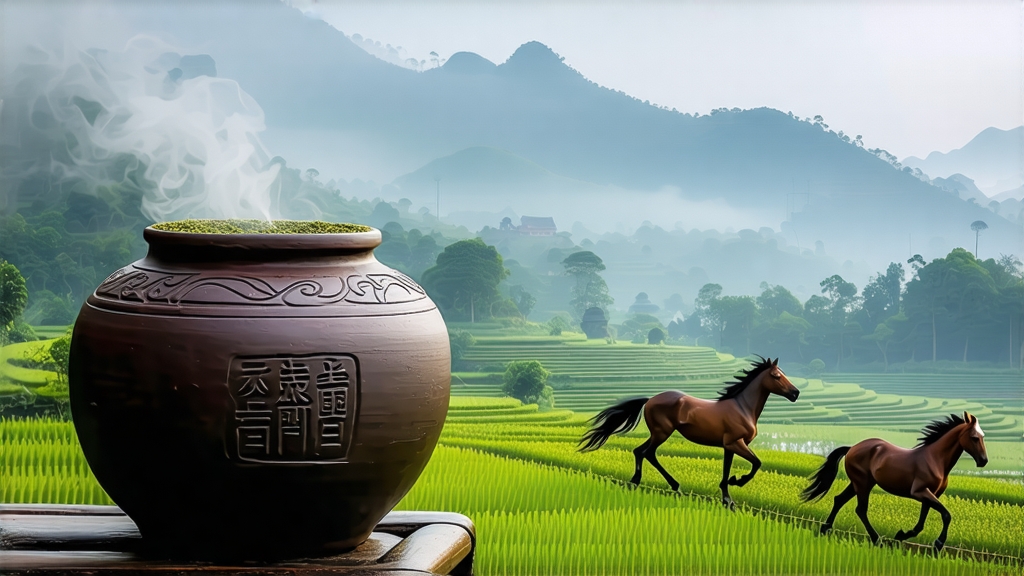
Liu Bao, literally “Six Forts,” is the name of a once-walled market town in Wuzhou, Guangxi Zhuang Autonomous Region, and also the name of the only dark tea that southern China has ever called its own. While Yunnan’s pu-erh has conquered auction catalogues and social-media feeds, Liu Bao has spent four centuries quietly mellowing in bamboo baskets, clay jars, and the holds of junks that sailed the Xun River to Hong Kong and then on to Malaya where tin-mine coolies swore it cured dampness and hunger. To international drinkers it remains an insider’s secret, yet within one infusion it can re-tell the entire saga of Chinese post-fermentation: the dialogue between leaf, microbe, humidity, and human patience.
History: From Border Garrison to Global Coolie Companion
The tea-horse road that linked Yunnan and Sichuan to Tibet is famous, but a southern spur left Guangxi through the limestone passes of the Dayao Mountains and reached the Gulf of Tonkin. Liu Bao town, garrisoned since the Ming dynasty, became a weigh-station for mountain tribes who exchanged pressed tea for salt and iron. By the late Qing the tea had acquired a reddish-black liquor and a reputation for settling stomachs in the malarial lowlands. When British steamships began calling at Wuzhou in 1858, Liu Bao was loaded as ballast, sold cheap in Singapore, and adopted by Nanyang Chinese who added milk and sugar but never stopped aging the leaf. In 1886 the colonial Straits Times mentioned “Liew Pow tea” as a hedge against beri-beri; during the Pacific War it was bartered for quinine. Returned to China in the 1990s as “overseas returned tea,” vintage baskets fetched prices higher than pu-erh of the same era, and the provincial government registered Liu Bao as a National Geographic Indication in 2011.
Micro-Terroirs within Guangxi
Guangxi straddles the Tropic of Cancer; karst peaks squeeze warm mist into narrow valleys whose red lateritic soil is rich in iron and aluminum. Within 150 km of Liu Bao town three micro-zones are now recognised. The highest, Gupi Mountain (800–1000 m), gives slow-growing leaves rich in amino acids that foster sweet, orchid-like undertones after aging. The middle belt around Dali village produces the classic “betel-nose” aroma—camphor, nutmeg, and a hint of dried longan—thanks to a dominant yeast species, Cyberlindnera jadinii, isolated by the Guangxi Academy of Agricultural Sciences. The lowest belt near the Xun River floodplain yields broader leaves with higher polyphenol oxidase activity; these are preferred for the traditional “cold-fermentation” technique that predates modern wet-piling. Each zone’s leaf can be blended or kept single-estate, giving collectors the same parcellated excitement found in Burgundy.
Craft: When the Leaf Lets the Microbes Speak
Liu Bao belongs to the “hou-fa” (post-fermented) family. The freshly picked leaves are first withered under subtropical sun for two hours, then wok-fried at 200 °C for eight minutes—longer than green tea but shorter than oolong—to kill surface enzymes while preserving deep-layer microbes. Rolling follows the ancient “dragon-&-phoenix” pattern: forty-five minutes of alternating light and heavy pressure that cracks the cuticle without fragmenting the blade. The twist is the “dui-wu” (wet-pile) stage invented here in 1958, yet rooted in centuries of boat-storage practice. Leaves are piled 70 cm high, misted to 28 % moisture, and covered with jute sacks. Every 48 hours the pile is turned and the core temperature kept below 55 °C; thermophilic Aspergillus niger and Bacillus subtilis bloom, converting catechins into theabrownins and releasing a forest-floor aroma. After 25–30 days the leaf is steamed, pressed into 40 kg bamboo baskets lined with wild banana leaf, and moved to an above-ground “tea-warehouse” where humidity hovers at 75 %. Here it will rest for a minimum of three years before market, but connoisseurs chase the 15-,